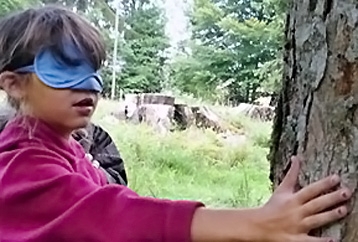Played in a park or forest, this year-round game involves discovering a tree while wearing a blindfold and learning how to tell one tree from another. This activity is proposed as part of the “Vive nos arbres” project, aimed at promoting the heritage of Geneva’s trees.
This sensory experience enables you to develop your sense of touch. The game can be played in any season in a park or a forest.
In this activity, a guide leads another person, who is blindfold, towards a tree. At the foot of the tree, the guide places the hands of their partner on the trunk so that they can feel the bark. The aim is to discover which tree it is.
Duration
30 minutes
Material
a scarf for two people
Procedure
Form pairs then decide who will act as guide first. The guide blindfolds the partner and guides them by voice or by placing a hand on their shoulder towards the tree of their choice. The tree chosen by the guide must be visible from the starting point. The guide tells the partner to touch the tree trunk. They can also put branches or leaves between their hands to help them identify the tree.
Once the blindfold person thinks they can recognise the tree (size of the trunk, type of bark), they are taken back to the starting point and the blindfold is removed. They then tell the guide which tree they identified.
If they don’t find the answer immediately, the guide can give them hints until they find the right tree. The two people then swap places and the guide wears the blindfold.
To prolong the experience
The guide only allows their partner to touch the trunk or the leaves. This makes the game a little more difficult.
Chat to each other about the different sensations felt during the game. Generally speaking, the sense we rely on most is sight. When, as in this case, we are momentarily deprived of this sense, we turn more to the sense of touch or hearing.
And why not try recognising a tree using the noises you hear as you stand at its foot? This new exercise requires good concentration and procures different sensations from the previous task. Surprises guaranteed!
Did you know?
All trees have different “skins”; by touching them, we notice that some types of bark are soft and smooth while others are rougher or damaged. Their appearance changes over time. As it grows older, bark becomes more marked, chipped and cracked. Sometimes tenants move in, including insects, mosses and lichens, whose habitat must be respected.
Contact
Conservatoire et jardin botaniques - Système d'information du patrimoine vert - Arbres
1 Chemin de l'Impératrice
1292
Chambésy
Suisse
Article modifié le 23.06.2022 à 11:30

